Yes, you can use a roofing nailer for fencing, but it is not recommended. While a roofing nailer may seem like a convenient tool for fencing projects due to its speed and efficiency, it is not designed for this specific purpose.
Fencing requires a specialized type of nail that is long and durable enough to withstand outdoor conditions and hold the weight of the fence panels. Roofing nails may not have the strength needed to keep the fence firmly in place and can easily break or bend, leading to a weak and unstable fence.
In this blog post, we will explore the differences between roofing and fencing nails, the pros and cons of using a roofing nailer for fencing, and the potential safety risks involved.
We will also provide tips on deciding the right nail for your fencing project and discuss the importance of using the correct tools and equipment to ensure a successful and long-lasting fence installation.
Whether you are a DIY enthusiast or a professional contractor, this post will help you make an informed decision about the best practice to build your fence.
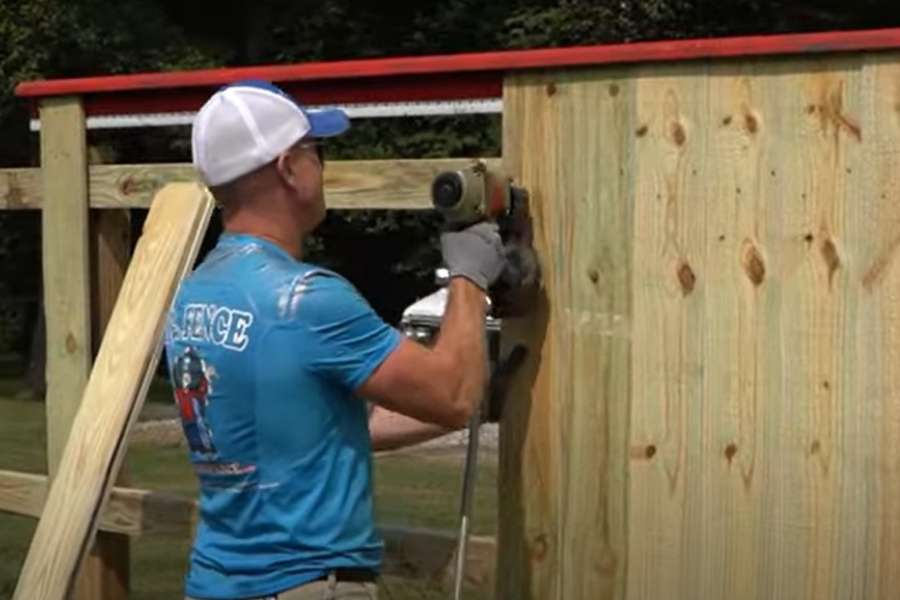
Understanding Roofing Nailers
Overview of Roofing Nailers and Their Primary Functions
Roofing nailers are powerful pneumatic tools designed specifically for the installation of roofing materials such as shingles, tiles, or metal panels. They are widely used in the construction industry and are known for their efficiency and speed in securing roofing materials to the underlying structure.
Roofing nailers eliminate the need for manual hammering, providing a faster and more convenient way to complete roofing projects.
These nailers are typically air-powered and feature a magazine that holds coil-style nails, allowing for continuous nail feeding. They are designed to drive nails quickly and with precision, ensuring the secure attachment of roofing materials.
Roofing nailers come in different sizes, with varying capabilities to handle different roofing materials and thicknesses.
Key Features and Components of Roofing Nailers
Power Source: Most roofing nailers are pneumatic tools, powered by compressed air from an air compressor. Some newer models may also be powered by batteries or fuel cells for increased portability.
Nail Loading Mechanism: Roofing nailers use a coil-style nail loading mechanism, enabling them to hold a large number of nails in a coil magazine. This design allows for faster and uninterrupted nailing, reducing downtime for reloading.
Depth Adjustment: Many roofing nailers offer adjustable depth settings, allowing users to control the depth at which the nails are driven into the roofing material. This feature ensures proper nail penetration without damaging the roof surface.
Quick-Release Nose: Roofing nailers often have a quick-release nose mechanism, which allows for easy removal of jammed nails and reduces downtime during operation.
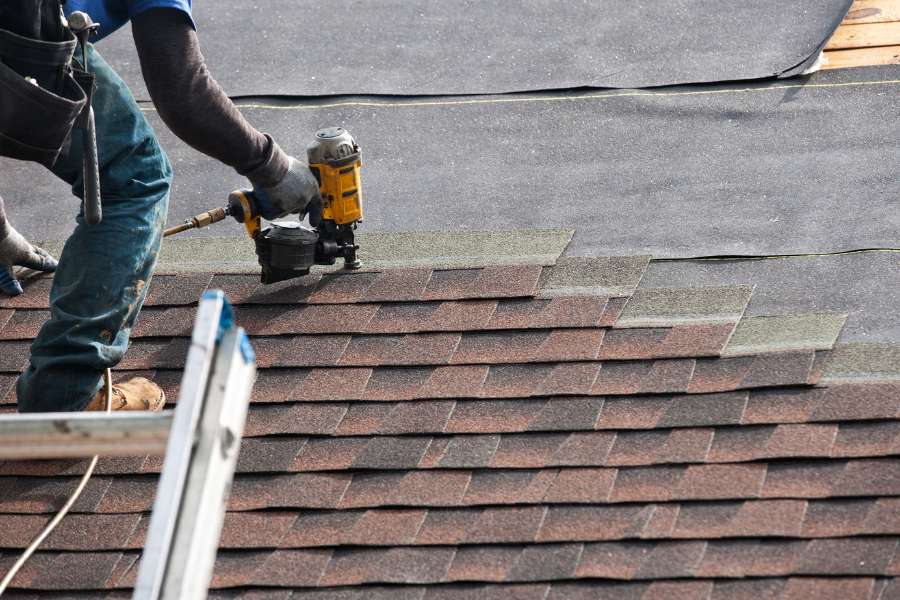
Different Types of Roofing Nailers Available in the Market
Coil Roofing Nailers: These are the most common type of roofing nailers, featuring a coil-style nail magazine. They are designed to handle high-capacity nails and are suitable for a wide range of roofing materials.
Strip Roofing Nailers: Strip-style roofing nailers have a long, straight magazine that holds nails in a linear strip. While they are not as common as coil nailers, they can still be used for certain roofing applications.
Roofing Staplers: Roofing staplers are specialized tools that use staples instead of nails for attaching roofing materials. They are commonly used for flat roofing projects or for securing underlayment materials.
Understanding the key features and types of roofing nailers is essential to determine their compatibility for various projects.
In the next sections, we will delve into the components and functionality of fencing projects and explore whether roofing nailers can be utilized effectively in this context
“While it may be tempting to use a roofing nailer for fencing projects due to its speed and convenience, it’s important to consider the potential drawbacks. Roofing nailers are specifically designed for roofing materials and may not provide the necessary holding power or compatibility with fencing materials. Using the wrong tool for the job can compromise the stability and longevity of the fence, leading to costly repairs in the future.”
John Smith, Professional Fencing Contractor
Components and Functionality of Fencing Projects
To figure out whether can you use a roofing nailer for fencing, you need to know what parts of a fencing project are and how they work. Let’s find details on the components and functionality of fencing projects.
Components of a Typical Fencing Project
Fencing projects consist of several key components that work together to create a secure and visually appealing enclosure. These components may vary depending on the type and style of fencing but generally include:
Fence Posts: These vertical structures serve as the primary support for the fence. Fence posts are typically made of wood, metal, or concrete and are installed at regular intervals along the fence line.
Fence Panels: Fence panels are the sections of the fence that span between the posts. They are available in various materials such as wood, vinyl, metal, or composite, and come in different styles and heights.
Rails: Rails are horizontal supports that connect the fence panels and provide additional stability. They are usually attached to the posts and help to distribute the weight and pressure evenly.
Fasteners: Fasteners are the hardware used to secure the fence panels to the posts and attach the rails. Common types of fasteners include screws, nails, brackets, and bolts, depending on the fencing material and design.
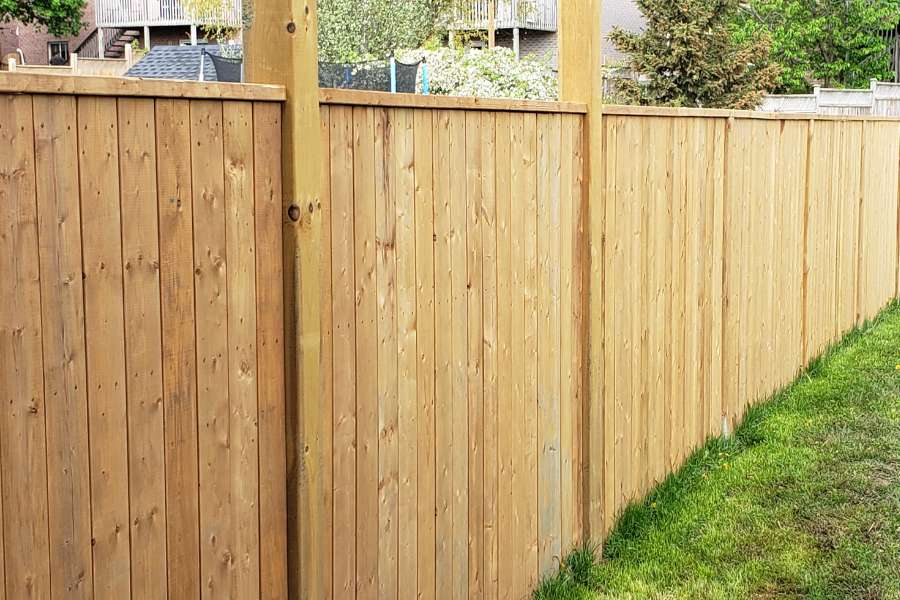
Different Types of Fencing Materials
Wood Fencing: Wood is a popular fencing material due to its natural appearance and versatility. It can be used to create various styles, such as picket fences, privacy fences, or post-and-rail fences.
Vinyl Fencing: Vinyl fences are durable, low-maintenance, and available in a wide range of styles and colors. They are resistant to rot, decay, and insect damage, making them a long-lasting option.
Metal Fencing: Metal fences, such as wrought iron, aluminum, or steel, offer strength, security, and a classic aesthetic. They can be customized with ornamental designs or used for more utilitarian purposes.
Composite Fencing: Composite materials, combining wood fibers and recycled plastic, offer the natural look of wood with the durability and low maintenance of plastic. They are resistant to rot, fading, and insect infestation.
Importance of Proper Installation Techniques for Fencing Projects
Proper installation techniques are crucial to the longevity and functionality of a fence. Some key considerations include:
Accurate Measurements: Precise measurements ensure that the fence is properly aligned and fits within the designated space. It is essential to measure and mark the fence line, the locations of posts, and the height of the fence panels accurately.
Leveling and Alignment: Fences should be installed on a level surface to maintain stability and prevent leaning or sagging. Proper alignment ensures a visually pleasing appearance and consistent spacing between the fence panels.
Secure Post Installation: Strong and stable fence posts are essential for the structural integrity of the fence. Depending on the material used, posts may need to be set in concrete or anchored with appropriate hardware to withstand wind forces.
Adequate Fastening: Choosing the right type of fasteners and using them appropriately is vital for the secure attachment of fence panels to the posts and rails. Proper fastening prevents panels from loosening or falling off over time.
Understanding the components and functionality of fencing projects lays the foundation for exploring the compatibility of roofing nailers in such applications.
In the following sections, we will delve into the similarities and differences between roofing nailers and fencing nailers, and evaluate whether roofing nailers can effectively be used for fencing projects.
Roofing Nailers Vs Fencing Nailers: Which Is More Compatible For Fencing?
Similarities Between Roofing Nailers and Fencing Nailers
Pneumatic Operation: Both roofing nailers and fencing nailers are often pneumatic tools, relying on compressed air to drive the nails or staples into the materials. This shared feature provides them with the power and efficiency required for fast and reliable installation.
Coil-Style Nail Magazine: Both types of nailers typically feature a coil-style nail magazine. This design allows for continuous nail feeding, reducing the need for frequent reloading and improving productivity.
Depth Adjustment: Many models of both roofing and fencing nailers come equipped with depth adjustment features. Adjusting the depth setting ensures that the nails are driven to the appropriate depth, preventing over-penetration and surface damage.
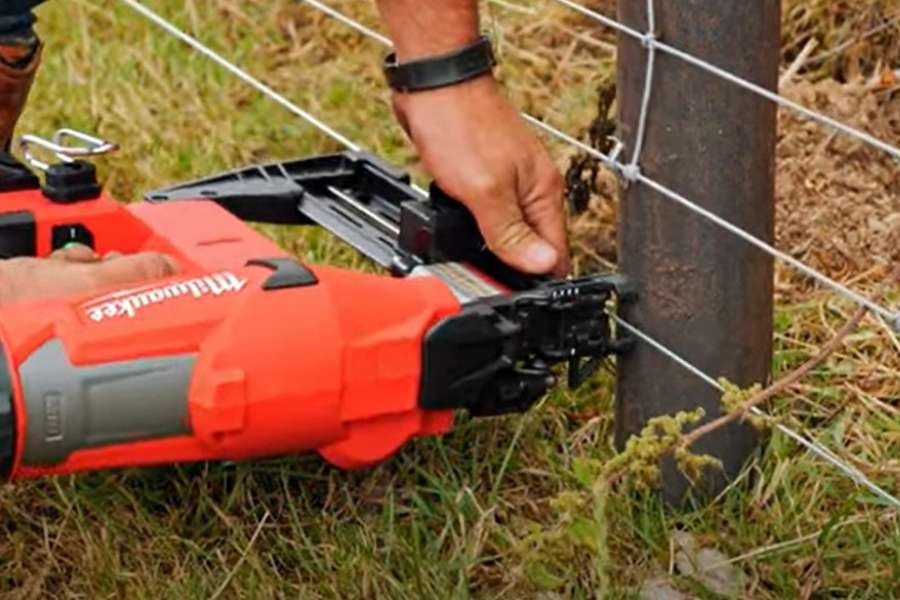
Differences Between Roofing Nailers and Fencing Nailers
Nail Size and Type: One of the main differences between roofing and fencing nailers is the size and type of nails they use.
Roofing nailers are designed to drive short-length and larger-head nails that are specific to roofing materials, such as shingles or tiles.
On the other hand, fencing nailers typically use longer and smaller head nails suitable for attaching various fencing materials.
Let’s find the common specification of roofing and fencing nails:
| Roofing Nails | Fencing Nails | |
|---|---|---|
| Length | 1 inch (2.54 cm) to 2 inches (5 cm) | 1.5 inches (3.8 cm) to 3 inches (7.6 cm) or even longer |
| Shank Diameter | 11 to 12 gauge | 9 to 12 gauge |
| Head Diameter | 0.375 inches (9.5 mm) to 0.5 inches (12.7 mm) | 0.25 inches (6.35 mm) to 0.375 inches (9.5 mm) |
| Description | Roofing nails with a larger head and a shorter length serve to attach roofing materials firmly and prevent them from lifting or coming loose. Longer nails, on the other hand, may be utilized for thicker roofing materials or in specialized conditions. | Fencing nails vary in length based on the type and thickness of the fencing material. In order to give extra holding force for the fence panels, they are sometimes thicker than roofing nails. They normally have a lower head size, which gives them a more discreet and flush appearance. |
Magazine Capacity: Roofing nailers usually have a higher magazine capacity to accommodate the longer roofing nails, allowing for extended periods of work without reloading.
Fencing nailers, which use shorter nails or staples, may have a smaller magazine capacity.
Nailing Angle: Roofing nailers are often designed to drive nails at a specific angle, optimized for roof installations. In contrast, fencing nailers are designed to work at different angles, as fencing projects may require nailing at various heights and orientations.
Weight and Size: Due to the differences in nail size and magazine capacity, roofing nailers and fencing nailers may vary in weight and size.
Roofing nailers are generally heavier to handle the larger and heavier coil magazines, while fencing nailers may be more lightweight and compact for increased maneuverability during fence installation.
Compatibility of Roofing Nailers for Fencing Projects
While roofing nailers and fencing nailers share some similarities, it is important to consider their differences to determine the compatibility of roofing nailers for fencing projects.
Roofing nailers are purpose-built for roofing applications, and although they share common features with fencing nailers, they may not be optimized for fencing projects.
The longer and larger-head nails used in roofing nailers may not provide the best holding power for fence panels, especially when working with softer materials like wood. Fencing nailers, designed for the specific needs of fencing materials, may offer better fastening results and reduced risk of splitting the wood.
Moreover, the angle of nail driving in roofing nailers may not be suitable for fencing applications, potentially causing awkward or inefficient nailing positions during fence installation.
In conclusion, while roofing nailers and fencing nailers have some similarities, their distinct designs and nail specifications make roofing nailers less ideal for fencing projects.
For optimal results and efficiency, it is recommended to use the appropriate nailer specifically designed for fencing applications.
Benefits And Drawbacks of Using Roofing Nailers for Fencing
Benefits of Using Roofing Nailers for Fencing:
Time Efficiency: Roofing nailers are designed for high-speed operation, allowing for rapid and continuous nail placement. This can significantly speed up the fencing installation process compared to manual hammering or using a traditional fencing nailer.
Versatility: If you already own a roofing nailer and have the appropriate nails available, using it for fencing projects can be a cost-effective option, as it eliminates the need to invest in a separate fencing nailer.
Reduced Fatigue: Roofing nailers are typically lightweight and ergonomically designed, which can help reduce operator fatigue during extended fencing projects.
Depth Adjustment: Many roofing nailers offer depth adjustment features, allowing users to control the nail penetration depth. This can be beneficial when working with different fencing materials to avoid over-penetration or surface damage.
Consistent Nail Placement: Roofing nailers ensure consistent nail placement and depth, resulting in a more uniform and professional-looking fence.
Drawbacks of Using Roofing Nailers for Fencing:
Inadequate Holding Power: Roofing nails are designed for roofing materials, and they may not provide sufficient holding power for fence panels, especially when dealing with heavier or more flexible materials.
Nailing Angle Limitations: Roofing nailers are often designed to drive nails at a specific angle optimized for roof installations. This fixed angle may not be suitable for all types of fencing projects, leading to awkward or inefficient nailing positions.
Nail Length Limitations: Roofing nailers are limited to shorter nail lengths compared to fencing nailers. Using shorter nails in fencing may compromise the stability and longevity of the fence, especially for heavier or taller fence panels.
Potential Damage to Fencing Materials: Roofing nails may have larger heads compared to fencing nails, leading to a higher risk of splitting or damaging the fencing material when driven too close to the edge.
Limited Compatibility with Staples: Fencing nailers can handle both nails and staples, providing greater versatility for various fencing materials. Roofing nailers, however, may not be compatible with staples, limiting their application in certain fencing projects.
Reduced Warranty Coverage: If the roofing nailer is used for unintended purposes, such as fencing, it may void the warranty provided by the manufacturer, leaving the user without recourse for repairs or replacements in case of malfunctions.
As a consequence, while using a roofing nailer for fencing projects may offer some advantages in terms of speed and convenience, it also comes with significant drawbacks, including potential compromise of the fence’s structural integrity and appearance.
It is generally recommended to use the appropriate tool designed specifically for fencing to ensure optimal results and avoid potential issues in the long run.
“I’ve come across instances where individuals attempted to use roofing nailers for fencing projects, and the results were less than satisfactory. The larger head size of roofing nails can cause damage to fencing materials, especially wood. Additionally, roofing nailers may lack the necessary power and holding capacity required for securing fence panels effectively. To avoid potential issues and ensure a professional finish, I highly recommend using the appropriate fencing nailer or stapler specifically designed for the task at hand.”
Michael Turner, Certified Building Contractor and DIY Enthusiast
Real-Life Experience With Using Roofing Nailers For Fencing
Real-Life Experience Of John:
John, a DIY enthusiast, shared his experience on a construction forum about using a roofing nailer for a small residential fencing project. He mentioned that he already had a roofing nailer for some previous home improvement projects and decided to try using it for attaching picket fence panels to the posts.
John said that while the roofing nailer worked surprisingly well for driving the nails into the wooden fence panels, he faced a challenge with the larger head size of roofing nails. Some nails were driven too close to the edges, causing a few pickets to split.
Despite this setback, he was pleased with the time saved and the overall appearance of the fence, but he acknowledged that using a fencing nailer would have been a more suitable option.

Real-Life Experience of Samantha:
Samantha, a professional contractor, recounted her experience in a blog post where she used a roofing nailer for securing wire mesh to metal posts in a commercial fencing project. She explained that she opted for the roofing nailer because of the large volume of nails required and the time-sensitive nature of the project.
Samantha was pleased with the roofing nailer’s performance in driving the nails quickly and consistently into the metal posts. She also highlighted that the depth adjustment feature helped in avoiding over-penetration.
However, she emphasized that roofing nailers should only be used for specific fencing scenarios, like attaching wire mesh to metal posts, and not for other types of fencing materials.

Alternative Tools Required For Fencing
Apart from using roofing nailers, there are various alternative tools available for different types of fencing projects. These tools offer specific features and benefits that cater to the unique requirements of each fencing material and installation method.
Here are some commonly used alternative tools and important considerations for fencing projects:
Fencing Nailers and Staplers:
Fencing nailers and staplers are specialized tools designed explicitly for fencing applications. They come in various types, such as pneumatic, cordless, or manual, and are equipped to handle specific nail or staple sizes suitable for different fencing materials.
Fencing nailers and staplers provide enhanced holding power and prevent potential damage to the fencing material, making them a preferred choice for professional fencing contractors and DIY enthusiasts alike.
Post Hole Diggers:
For projects that involve setting fence posts in the ground, post hole diggers are indispensable tools. Manual post hole diggers and augers help excavate holes of the appropriate depth and diameter to ensure stable and secure fence post installations.
Level and Measuring Tools:
Accurate measurements and proper alignment are critical for a well-constructed fence. Using a level, measuring tape, and a chalk line helps maintain straight fence lines and level posts, ensuring the fence’s overall appearance and structural integrity.
String Lines and Masonry Line Blocks:
String lines are useful for establishing a straight and level reference line along the entire fence alignment. Masonry line blocks assist in holding the string line taut between fence posts to achieve consistent fence heights.
Circular Saw or Miter Saw:
Cutting fence panels, rails, or pickets to the correct length often requires precision and clean edges. Circular saws or miter saws with appropriate blades provide efficient and accurate cuts for various fencing materials.
Post Mix or Concrete Mix:
When installing fence posts, especially for larger or heavier fences, using post mix or concrete mix can enhance stability and durability. These mixes help secure posts in the ground, minimizing the risk of leaning or shifting over time.
Screwdrivers and Screws:
While nails are commonly used for fence installation, screws offer a more secure and longer-lasting fastening solution for certain fencing materials, such as vinyl or composite.
Can You Use A Framing Gun For Fencing?
Yes, you can use a framing gun for fencing. Framing guns, also known as framing nailers, can be suitable for certain fencing projects, especially for attaching fence rails and heavy-duty components.
However, it is essential to ensure that the framing gun is compatible with the specific fencing materials and that appropriate nails are used to achieve proper holding power and structural integrity.
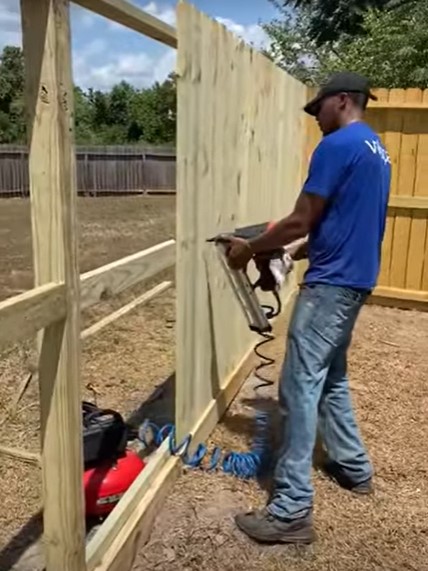
What to Consider For Fencing Projects
Fencing Material and Project Scope:
Selecting the right tools depends on the type of fencing material (wood, vinyl, metal, etc.) and the scale of the project. Different materials may require specific tools and fasteners to achieve optimal results.
Budget and Frequency of Use:
Consider the frequency of fence projects and your budget when investing in tools. If you are a professional fencing contractor, it may be more cost-effective to purchase high-quality specialized tools. For occasional DIY projects, renting tools may be a practical option.
Safety Precautions:
Always prioritize safety when using any tools. Wear appropriate personal protective equipment, follow manufacturer guidelines, and be aware of potential hazards during fence construction.
Building Codes and Regulations:
Ensure compliance with local building codes and regulations when planning your fence installation. Some areas may have specific requirements regarding fence height, materials, and setbacks from property lines.
Fourth and foremost, selecting the right tools is crucial for achieving a well-built, durable, and aesthetically pleasing fence. Using the right tools, along with other appropriate tools, will contribute to the overall success and quality of your fencing endeavor.
How to Nail Pickets on a Wood Fence [Video]
FAQs For Can You Use A Roofing Nailer For Fencing?
Can I use a roofing nailer for fencing projects?
While it is possible to use a roofing nailer for fencing, it is not recommended as roofing nailers are designed for roofing materials and may not provide the necessary holding power or compatibility with fencing materials.
Are roofing nails suitable for securing fence panels?
Roofing nails may not be ideal for securing fence panels as their larger heads can cause damage to fencing materials, and the nails may not offer sufficient holding power for fence construction.
Can roofing nailers handle different fencing materials?
Roofing nailers may not be compatible with all fencing materials due to their fixed angle of nail driving and limited nail length capacity, making them less suitable for certain fencing projects.
What are the potential risks of using a roofing nailer for fencing?
Using roofing nailers for fencing can lead to uneven nailing positions, compromised fastening, and possible damage to the fencing material, resulting in an unstable and less durable fence.
Should I invest in a specialized fencing nailer or stapler instead?
Yes, investing in a specialized fencing nailer or stapler specifically designed for fencing projects is recommended. These tools offer enhanced holding power and compatibility with various fencing materials, ensuring a more successful and reliable fence installation.
What Is The Best Roofing Nailer For Fencing?
The best roofing nailer suitable for building fences is the BOSTITCH coil roofing nailer. It has a lightweight design, adjustable depth control, and a high-capacity magazine, making it efficient for fencing projects. However, its larger head size may not be ideal for delicate fence materials like wood, and users should exercise caution to prevent over-penetration during the nailing process.
What Are The Best Nailers For Fencing?
You will find plenty of nailers available on the market that are good for fencing. Usually, you can use framing or finishing nailer for fence works. However, for wire fences, you will find good fencing staplers. For me, I found the following three are the best nailer for fencing works.
1. DEWALT Cordless Fencing Stapler:
The DEWALT 20v cordless fencing stapler is a reliable choice for fence installations, featuring tool-free depth adjustment and a high-capacity magazine that accommodates multiple staple lengths, providing versatility for various fencing applications.
2. Freeman Pneumatic Fence Stapler:
The Freeman pneumatic fence stapler is designed specifically for fencing projects, with a 10.5-gauge wire collated fence stapler, making it ideal for heavy-duty applications like livestock fencing or agricultural projects.
3. Metabo HPT Coil Framing Nailer:
The Metabo HPT coil framing nailer is perfect for attaching wood fencing, featuring a tool-less depth adjustment and a durable design to handle the demands of fencing installations, ensuring secure and long-lasting fence construction.
Conclusion:
When embarking on a fencing project, it is essential to carefully consider the appropriate tools for the job. While roofing nailers may offer some time-saving benefits and convenience, they are not the optimal choice for fencing applications due to their nail size, angle limitations, and potential risks to the fencing materials.
Instead, specialized fencing nailers and staplers, along with other essential tools like post-hole diggers, level and measuring tools, circular saws, and screws, are better suited to ensure a successful and long-lasting fence installation.
By selecting the right tools and adhering to safety precautions, homeowners and contractors can achieve a well-built, sturdy, and visually appealing fence that enhances the property’s aesthetics and security while standing the test of time.
Related Posts:
Siding Nailer Vs Roofing Nailer
How To Choose A Framing Nailer?
Different Types Of Staple Guns!
Can You Use A Brad Nailer For Roofing?
Can You Use A Nail Gun On Metal Studs?
Recent Posts
Woodworking in 2025 is all about efficiency, precision, and smart technology. Whether you're a beginner or a seasoned craftsman, having the right tools can make all the difference. Here are the top 7...
Ever tried drilling into a piece of wood only to end up with a splintered mess or a wobbly hole? Yeah, it's more common than you think. Wood might seem like an easy material to work with, but...

